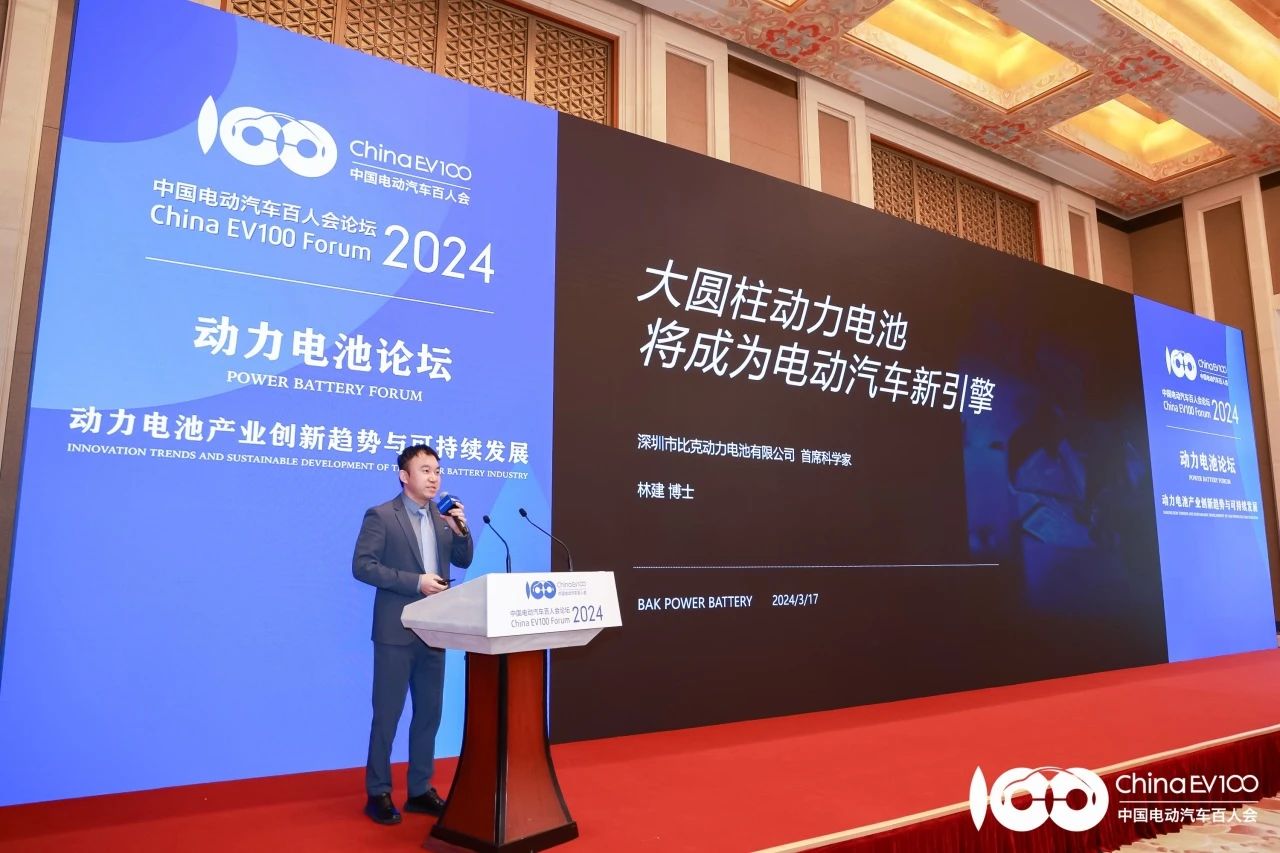BAK Battery - Lin Jian: Big Cylindrical Power Batteries Will Emerge as the New Engine of Electric Vehicles, Opening a New Era
From March 15 to March 17, the China EV100 Forum 2024 was held at Diaoyutai State Guesthouse in Beijing, focusing on helping enterprises get insight into the competition situation of the industry and address challenges with firm confidence in the industry. At the forum, Dr. Lin Jian from Shenzhen BAK Power Battery Co., Ltd. (hereinafter referred to as “BAK Battery”) delivered a keynote speech to analyze the global power battery market. According to Dr. Lin, with the global battery supply and demand imbalance, big cylindrical power batteries will emerge as the new engine of electric vehicles. He said, BAK Battery, as an early mover in the industry, has achieved innovative breakthroughs and improved the mass production capacity of big cylindrical batteries. The ultimate goal is to deliver high-quality power batteries for global electric vehicles.

Opportunity - Seizing the opportunity in the new era of power batteries
2023 is a crucial year for electric vehicles. As reported by the China Passenger Car Association (CPCA) and China EV100 Forum, with accelerated market growth, the penetration rate of global electric vehicles in 2023 reached up to 22%. With the market penetration rate rising to 35.7%, China’s electric vehicle sales in 2023 totaled 7.7 million units, a year-on-year surge to 36%.
However, due to the dramatic expansion of the production capacity of power batteries for such a booming new energy vehicle industry, the global power battery market is facing an imbalance of supply exceeding demand. As IEA data shows, in 2023, the global effective demand for power batteries is about 1,600 GWh, while the supply has reached a striking 4,400 GWh, and the gap is expected to widen by 2030. Lin Jian said that as China is the world’s largest power battery producer, Chinese power battery manufacturers, facing such a supply-demand imbalance, should optimize their market layouts and strategies. Specifically, they should explore the overseas market and, as the top priority, develop novel technologies and close outdated production facilities.
Leveraging the new mainstream technology, big cylindrical batteries come at the right time. Compared with prismatic and polymer batteries, big cylindrical batteries are much more applicable for mid- and high-end electric vehicles. They are expected to promote the iterative upgrade of power battery technologies and emerge as the new engine of electric vehicles.
Technology breakthrough - Advancing technologies to bring hexagonal performance to a new level
With higher energy density than other types of batteries, big cylindrical batteries feature longer battery life, enhanced safety, and high cost-efficiency, fitting the three “rigid demands” of new energy vehicles for battery life, product safety, and cost.
However, many technical barriers exist to the technical process of such excellent “hexagonal” products of big cylindrical batteries. In recent years, Chinese manufacturers have conducted scientific research on various technical processes and achieved technology breakthroughs in big cylindrical batteries. As Dr. Lin Jian introduced and iterated to the third generation, BAK's big cylindrical batteries deliver improved fast-charging and safety performance by continuous tab technology. BAK Battery’s 3rd-generation big cylindrical power batteries currently support 4C ultra-fast charging to complete charge from 10% to 80% within 20 minutes when the ambient temperature is 25°C. Those batteries have successfully passed the cell nail penetration test (triggering thermal runaway), small-module nail penetration test, and small-module heating test.
Mass production - Expanding mass production capacity to outpace competitors
To become a new electric vehicle engine, cylindrical power batteries must be produced in mass production.
According to Dr. Lin Jian, three major challenges of technique, raw material, and carbon reduction are in the way of putting big cylindrical power batteries into mass production. The various manufacturing processes of big cylindrical power battery cells require higher consistency and reliability. How to improve the processing of anode and cathode electrode materials themselves and the tensile strength of foils and separator needs to be addressed by the upstream material suppliers. As for carbon emission reduction, the energy efficiency of the production capacity of the big cylindrical power batteries needs to be aligned with the country’s carbon goals.
To address these challenges, BAK Battery has built a new-generation digitalized production base - BAK Battery Zhengzhou No. 2 Factory to accelerate the large-scale mass production of big cylindrical power batteries. The factory implements AI-based big data analysis and quality control using BAK Battery's database. Powered by digital technologies, BAK Battery plans to achieve staged expansion of mass production of big cylindrical batteries: 2.5 GWh by the end of 2024, 15 GWh by the end of 2026, and 30 GWh by the end of 2028.
The tailwind generated by the booming new energy vehicle industry brings big cylindrical power batteries off to a new level. As an early and major player in China’s power battery industry, BAK Battery remains true to its founding spirit forged 23 years ago. It will continue to boost the transformative development of the new energy vehicles industry globally, with big cylindrical batteries as a new engine for future electric vehicles.
Other News
-
BAK Battery presented at CIBF...
From April 27 to 29, 2024, the 16th China International Battery Fair (CIB...
+More27 2024-04 -
BAK Battery Unveils Cutting-E...
Recently, Shenzhen BAK Power Battery Co., Ltd. (hereinafter referred t...
+More27 2024-04





